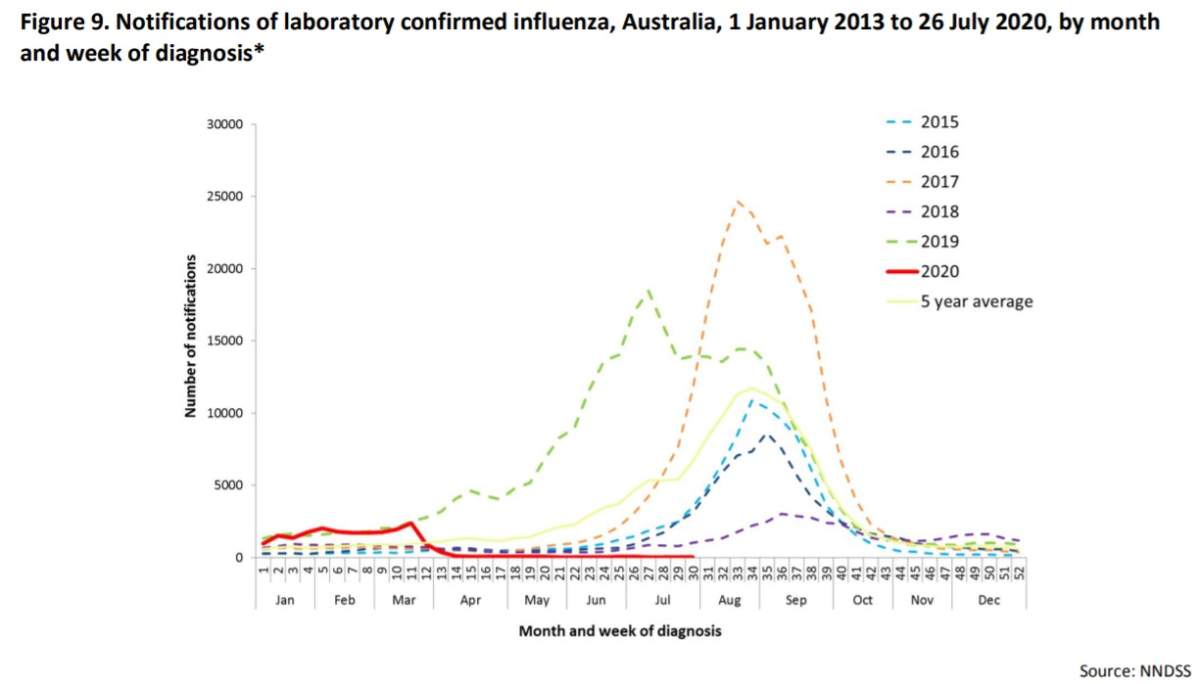It’s the peak of flu season in Australia. At least it should be.

Usually, flu season runs through Australia’s winter — Canada’s summer — and officials look to Australia for clues on what Canada’s upcoming flu season could look like in terms of strains, caseload and severity.
But with Australian flu numbers at their lowest in years, officials have a different takeaway this time when they look Down Under: that measures used to combat the coronavirus outbreak could be having an effect on other viruses, too.
“I think it’s telling us that influenza is preventable in the same way that COVID is preventable, to some extent, anyway,” said Dr. Lynora Saxinger, an infectious disease specialist at the University of Alberta.
In a report released July 31, Australia’s health ministry notes that “influenza and influenza-like illness (ILI) activity are lower than average across all systems for this time of year.”
Australia had just 36 laboratory-confirmed flu deaths from January to July 26, 2020, the report said. Over the same period a year earlier, there were 383 confirmed deaths.
A chart in this year’s report shows the dramatic drop in confirmed flu cases, with them nearly flatlining since April.
Saxinger attributes this dramatic decline in flu numbers to lockdowns and other measures that Australia enacted to fight COVID-19.

Get weekly health news
“They were tracking into what looked to be maybe early signs of severe flu season, like their inter-seasonal flu levels were relatively high,” she said. “And then in mid-March, everything plummeted because that’s when everything was shutting down and there was lockdown. And then for the rest of the time period, it’s been running essentially below the radar.”
The same thing could happen in Canada, suggests Dr. Jeff Kwong, interim director of the Centre for Vaccine-Preventable Diseases at the University of Toronto.
In Australia, “the public health measures against COVID have also helped to suppress influenza activity,” he said.
“I think if we’re able to maintain our current intensity of public health measures – the physical distancing, handwashing, wearing masks, all that sort of thing – I think we might see very little influenza activity.”

What we don’t want, Saxinger said, is to have a flu outbreak and a COVID-19 outbreak at the same time.
“Ordinarily in hospitals, in the December, January, February range, we have overfull ICUs and overfull medical wards because of influenza and complications of influenza,” she said.
“If there’s this COVID resurgence at the same time, everyone was looking at that scenario with really serious concern because we wouldn’t have capacity. We barely have capacity every year anyway.”
It’s something that worries the Public Health Agency of Canada, too. In a press conference Friday, officials said that they are preparing for this scenario, just in case.
“We are planning for an influenza season to coincide with a potential surge in COVID-19 cases,” said Dr. Theresa Tam, Canada’s chief public health officer.
As such, she said, provinces are preparing by stepping up prevention campaigns and ordering extra influenza vaccine, even as they keep an eye on hospital capacity.
“It remains to be seen, but we are planning for the fact that yes, influenza and other respiratory illnesses could take up more beds.”
Of course, keeping up our virus-prevention efforts becomes trickier as kids go back to school, people return to offices and we spend more time indoors.
This is why getting your flu shot this year is more important than ever, said Dr. Ran Goldman, a pediatrician at B.C. Children’s Hospital and a professor at the University of British Columbia. He just completed a survey of parents that found that half of parents said they would get their child vaccinated against influenza this year – a much higher number than normal.
He’d like to see it pushed even higher, though.
“I think one of our roles for the coming year is to increase this number and talk to the other half of parents and convince them to give their children a flu vaccine this year as well, because this is an effort of a community, of a whole country or the whole globe. We can’t just fight this with half of the people.”

Getting a flu shot doesn’t just protect you, he said, it can also help prevent you from spreading the potentially severe illnesses to vulnerable members of your family and community. And if you do catch the flu, it can help decrease your chances of developing complications.
Also, it’s possible to catch both flu and the coronavirus at the same time, which would be a “bit of bad luck,” Kwong said.
“You probably want to avoid that.”





Comments